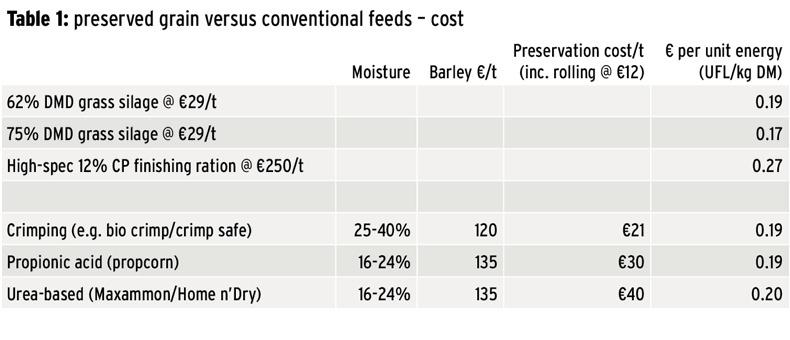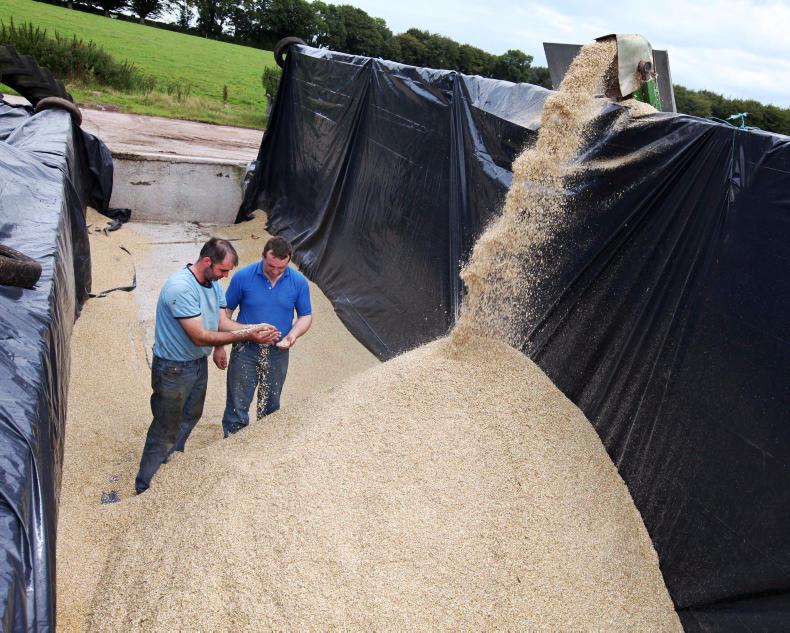Grain prices are likely to be competitive again this year, meaning livestock farmers who have storage facilities will be looking more closely at the option of buying grain direct for feeding.
Some farmers will store small amounts of grain without treatment.
Ideally, you need grain to be at 14% moisture or below for safe storage over an extended duration.
As the moisture content increases, the safe storage period decreases.
To avoid the grain spoiling, it should be stored in shallow piles.
This, however, requires additional space.
So, what are the treatment options that are available to farmers who are considering buying and storing larger volumes of their own grain?
Crimping
Before feeding grain, it should be processed in such a way that the protective seed coat is marginalised – to allow bugs in the animal’s digestive system to access the nutrients inside. The process of chewing will only achieve this to a certain extent. Exposing these nutrients is also an important step in some common preservation methods.
Rolling is the most widely used option and currently costs around €12/t.
Grain can be rolled just prior to feed out, though it typically happens as part of a preservation/treatment process.
Crimping is one such treatment process.
This involves the harvesting of grain at 25% to 40% moisture, often three to four weeks ahead of the conventional harvest date.
The grain is rolled and ensiled until feeding time. An additive is mixed in during the rolling process, when the seed coat is cracked, to reduce the pH to around 4 and initiate the fermentation process.
The big advantage of crimping is that grain can be easily stored in an outdoor silage pit and covered with polythene.
It’s not as critical to keep the grain as dry as with other options.
However, there are disadvantages too. Contractors aren’t keen on cutting crops at 30% moisture as it’s tough on their machines. Harvesting early also leaves green straw behind. It can also be difficult to value grain at 30% moisture compared to 20%.
Propionic acid
More recently, there has been a gradual progression to the use of organic acids such as propionic acid (propcorn).
Applied to mature grain with moisture content from 16% to 24%, propionic acid preservation has been used for decades. It has become popular again as crimping machines become more readily available across the country.
Machine availability means that the grain could be rolled and the acid applied at the same time.
The big plus with propionic acid-treated grain is that it’s immediately ready to feed.
Grain at 20% moisture needs 10l/t of propcorn, with 18% grain needing 8l/t. Treated grain should be stored on a dry floor and must be kept dry.
While vermin can be an issue with crimped grain, it is much less of an problem with propcorn-treated grain.
The issue with feeding propcorn-treated grain is the acid load on the rumen. If the aim is to push cattle on high levels of meal, doing so with propcorn-treated grain is dangerous, even with slow build-up and proper feeding management.
Consider instead using it to replace 40% to 60% of your bought-in ration in a high-concentrate diet.
The bought-in ration has an important role in the diet, as it will contain important buffers, yeasts and a mineral/vitamin mix.
Urea/ammonia treatment
While the above preservation methods are based on reducing pH (increasing acidity), other preservation additives work on the principle of increasing the pH.
Maxammon and Home n’Dry are two such products. In simple terms, they are combinations of feed-grade urea, full-fat soya bean, essential oils and an advanced grain enzyme,which will release ammonia within the ensiled grain, thereby rapidly preserving the grain.
As they’re alkaline-based, they raise the pH (decrease acidity) of the grain to between 8.5 and 9.5. It is a safer feed than crimped or propcorn grain in this regard and can be fed at higher rates.
Best practice with these is to roll the grain and apply the additive all at once, at a rate of around 20-40kg/t.
In order to maximise benefits from the product, it should be sealed under plastic for a period of two weeks.
The grain can be stored outside. However, moisture must not be let get into the grain.
While this product is marginally more costly than the others, it can be argued that the benefits outweigh the spend. The higher pH reduces the risk of acidosis, while increasing protein by 30% is another.
Urea is converted to ammonia, which is a building block of amino acids and increases the protein content.
The quality of the additional protein provided is comparable to that of distiller’s grain.

Grain will likely be cheap again this back end. If barley can be bought at €135/t off the combine and compound rations costs €235-plus/t there is definitely scope for farm to farm feed sourcing as a means to save money. However, consider the other costs involved too.
Have you got a storage facility and is it adequate?
Allow also for 5% to 7% loss between preservation, storage and feedout.
Maxammon- and Home n’Dry-treated grain is relatively high in protein, but crimping and propcorn are not.
A protein balancer will be needed where these are being fed to growing cattle or milkers.
Read more
Growing kale – a winter feed option
How a tonne of €140 green barley ends up as €250 in feed
Full coverage: Reseeding Focus 2017
Grain prices are likely to be competitive again this year, meaning livestock farmers who have storage facilities will be looking more closely at the option of buying grain direct for feeding.
Some farmers will store small amounts of grain without treatment.
Ideally, you need grain to be at 14% moisture or below for safe storage over an extended duration.
As the moisture content increases, the safe storage period decreases.
To avoid the grain spoiling, it should be stored in shallow piles.
This, however, requires additional space.
So, what are the treatment options that are available to farmers who are considering buying and storing larger volumes of their own grain?
Crimping
Before feeding grain, it should be processed in such a way that the protective seed coat is marginalised – to allow bugs in the animal’s digestive system to access the nutrients inside. The process of chewing will only achieve this to a certain extent. Exposing these nutrients is also an important step in some common preservation methods.
Rolling is the most widely used option and currently costs around €12/t.
Grain can be rolled just prior to feed out, though it typically happens as part of a preservation/treatment process.
Crimping is one such treatment process.
This involves the harvesting of grain at 25% to 40% moisture, often three to four weeks ahead of the conventional harvest date.
The grain is rolled and ensiled until feeding time. An additive is mixed in during the rolling process, when the seed coat is cracked, to reduce the pH to around 4 and initiate the fermentation process.
The big advantage of crimping is that grain can be easily stored in an outdoor silage pit and covered with polythene.
It’s not as critical to keep the grain as dry as with other options.
However, there are disadvantages too. Contractors aren’t keen on cutting crops at 30% moisture as it’s tough on their machines. Harvesting early also leaves green straw behind. It can also be difficult to value grain at 30% moisture compared to 20%.
Propionic acid
More recently, there has been a gradual progression to the use of organic acids such as propionic acid (propcorn).
Applied to mature grain with moisture content from 16% to 24%, propionic acid preservation has been used for decades. It has become popular again as crimping machines become more readily available across the country.
Machine availability means that the grain could be rolled and the acid applied at the same time.
The big plus with propionic acid-treated grain is that it’s immediately ready to feed.
Grain at 20% moisture needs 10l/t of propcorn, with 18% grain needing 8l/t. Treated grain should be stored on a dry floor and must be kept dry.
While vermin can be an issue with crimped grain, it is much less of an problem with propcorn-treated grain.
The issue with feeding propcorn-treated grain is the acid load on the rumen. If the aim is to push cattle on high levels of meal, doing so with propcorn-treated grain is dangerous, even with slow build-up and proper feeding management.
Consider instead using it to replace 40% to 60% of your bought-in ration in a high-concentrate diet.
The bought-in ration has an important role in the diet, as it will contain important buffers, yeasts and a mineral/vitamin mix.
Urea/ammonia treatment
While the above preservation methods are based on reducing pH (increasing acidity), other preservation additives work on the principle of increasing the pH.
Maxammon and Home n’Dry are two such products. In simple terms, they are combinations of feed-grade urea, full-fat soya bean, essential oils and an advanced grain enzyme,which will release ammonia within the ensiled grain, thereby rapidly preserving the grain.
As they’re alkaline-based, they raise the pH (decrease acidity) of the grain to between 8.5 and 9.5. It is a safer feed than crimped or propcorn grain in this regard and can be fed at higher rates.
Best practice with these is to roll the grain and apply the additive all at once, at a rate of around 20-40kg/t.
In order to maximise benefits from the product, it should be sealed under plastic for a period of two weeks.
The grain can be stored outside. However, moisture must not be let get into the grain.
While this product is marginally more costly than the others, it can be argued that the benefits outweigh the spend. The higher pH reduces the risk of acidosis, while increasing protein by 30% is another.
Urea is converted to ammonia, which is a building block of amino acids and increases the protein content.
The quality of the additional protein provided is comparable to that of distiller’s grain.

Grain will likely be cheap again this back end. If barley can be bought at €135/t off the combine and compound rations costs €235-plus/t there is definitely scope for farm to farm feed sourcing as a means to save money. However, consider the other costs involved too.
Have you got a storage facility and is it adequate?
Allow also for 5% to 7% loss between preservation, storage and feedout.
Maxammon- and Home n’Dry-treated grain is relatively high in protein, but crimping and propcorn are not.
A protein balancer will be needed where these are being fed to growing cattle or milkers.
Read more
Growing kale – a winter feed option
How a tonne of €140 green barley ends up as €250 in feed
Full coverage: Reseeding Focus 2017







 This is a subscriber-only article
This is a subscriber-only article











SHARING OPTIONS: